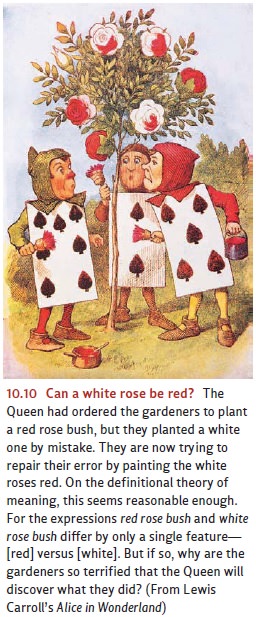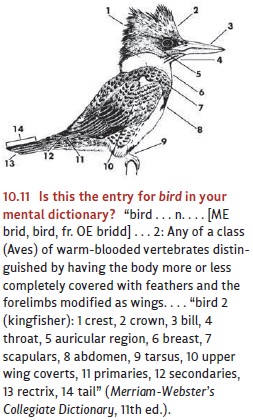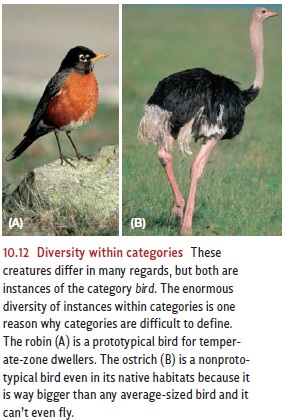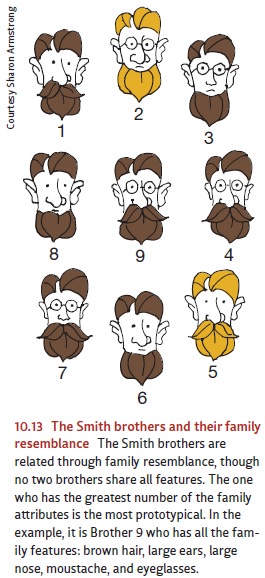Chapter: Psychology: Language
Psychology Language: Meanings of Words
The Meanings of
Words
Word meanings are of many
different kinds. Some words such as Madonna
and Batman describe individuals in
the real and imaginary worlds; others such as dog and unicorn are more
general and describe categories of things. Yet other words describesubstances (water, Kryptonite), properties (green,
imaginary), relations (similar, uncle), quantities (some,
zillions), actions (run, transform),
states of mind (knowing, hoping) or being (am, seem), and manners of
doing (carefully, musically). A moment’s thought reveals
that the type of meaning is correlated with the so-called parts of speech, with
things and stuff generally labeled by nouns, acts and states by verbs,
properties by adjectives, and manners by adverbs. As can be expected with any
informally evolving and changing system like a human language, these
form-to-meaning correlations are not perfect and sometimes the exceptions can
be striking. For instance, it is just an arbitrary fact, without semantic
explanation, that in present-day English the word thunder can appear as either a noun or a verb (Thunder frightens my dog; The
king thun-ders out his commands to the peasants) whereas lightning is a noun only (Lightning fright-ens my dog sounds fine,
but The king lightnings down his commands to the peasants soundsungrammatical).
Despite the fact that the form-meanings correlations are imperfect, they are never-theless strong enough so that both children and adults successfully use form class (noun, verb, etc.) as a clue to the meanings of new words (R. Brown, 1957). Distinctions among word types accord with the representation of language in the brain: For exam-ple, words naming things (usually nouns) are retrieved from different neural systems than words naming actions (usually verbs), probably as a result of the different func-tion morphemes that occur with these two word types (e.g., the plural -s occurs with nouns but the past-tense -ed occurs with verbs; Tyler, Bright, Fletcher, & Stamatakis, 2004). These distinct neural systems can be independently compromised in brain injury, so that the person loses the use of one type of word but still maintains the other type (Bates, Chen, Tzeng, Li, & Opie, 1991; Caramazza & Hillis, 1991).
THE DEFINITIONAL THEORYOF WORDMEANING
At first glance, the words of a
language seem to be like little atoms of meaning, each distinct from all the
others. But several theories of word meaning assert that only a handful of
words in a language describe elementary, “simple” ideas or concepts. The rest
are more like molecules: They
are composites of
more elementary atoms
of meaning. Thus, words like yellow
and round might indeed name simple
ideas or concepts, but other words seem more complex: For example, the words canary andbanana involve not only
yellowness but other elements as well (in these cases, animal and fruit,
respectively) (Hume, 1739; Jackendoff, 2002; Katz & Fodor, 1963; Figure
10.9).


These observations are central to
a definitional theory of word meaning,
which states that words are represented in our minds much as they are in
ordinary dictionar-ies (Figure 10.10). According to this theory, each word can
be understood as a bundle of meaning atoms, or semantic features. In a dictionary, for example, a bachelor would be defined as “an adult
human male who has never married.” The psychological repre-sentation of bachelor in our brains according to the
definitional theory of meaning is much the same: The full meaning of each word
is a set of semantic atoms that are essen-tial for membership in the category
named by the word. Thus, to continue with the same example, bachelor is composed of the set of
semantic features [single], [human], [adult], and [male]. These features are
individually necessary for bachelorhood and so, if some creature is missing any
one of them (e.g., if the creature is married, or is an adult male duck), it
could not correctly be called “a bachelor.” And this set of features is bachelorhood,
regardless of other traits: Some man may be tall or short, flirtatious or shy,
but still can correctly be called a bachelor. The theory thus describes the
boundary conditions for bachelorhood, and in so doing would account for how we
identify and label those who are (and are not) bachelors when we encounter
them.
The definitional theory of meaning also describes many other important facts about how words seem to be related to each other: Words that share features are to that extent predicted to be similar in meaning (wicked-evil); words with single opposed features are antonyms (wickedgood); words that share no features (wicked-turqoise) are unrelated in meaning. The feature similarities also allow us to identify clusters of words—for example, bachelor, uncle, brother, gander, and stallion—by all being items that share the fea-ture of [maleness].*
Summarizing, then, the proposal
is that we carry a semantic-feature definition in our heads for each word in
our vocabulary. These features allow us to recognize new instances of each
category, to understand how words are meaningfully related to each other, and
to understand the sentences of which the words are the component parts.
THE PROTOTYPETHEORYOF MEANING
The definitional theory faces
several problems. For one thing, it is surprisingly hard to come up with
definitions that cover all the uses of words. Consider for example the
(proposed) definition of bird in
Figure 10.11. This definition seems promising, but, in fact, not all birds are
feathered (neither baby birds nor plucked birds have feathers, but still they
are birds). The author of the dictionary definition in the figure acknowledges
this problem by hedging on the feathers issue, writing “more or less completely
covered with feathers.” And the picture helps in some ways, filling in what the
words miss, but notice that the picture is far too particular to describe the
range of real birds; it hardly seems appropriate for the emus or the
albatrosses (Fodor, 1983; L . Murphy, 2002).

A related problem is that some members
of a meaning category appear to exemplify that category better than others do.
Thus, a German Shepherd strikes us as a more typical dog than a Pekinese, and
an armchair is somehow a better example of furni-ture than is a reading lamp.
This typicality difference is at odds with the analysis we have described thus
far, whose aim was to specify the necessary and sufficient attrib-utes that
define a concept. A dictionary-type definition is meant to locate the
bound-aries of a category, so that each case is either inside the boundary (and
thus a member of the category) or outside (and thus not a member). But this
simple in-or-out division seems not to capture the intuition that some category
members are “better” than others.
In general, the definitional
theory fails even to pick out all and only the category members as it was
designed to do. Returning to the example with which we began: Are there really
semantic features that characterize all birds and that characterize birds only?
One might think that being able to fly is a feature of all birds, but it is
not. (Ostriches can’t fly.) And not everything that lays eggs (turtles), or
flies (airplanes, helicopters), or has feathers (hats, quilts, quill pens) is a
bird. Besides, more than half the birds don’t lay eggs at all (the babies and
the males). With all these exceptions in mind, perhaps it is wrong to suppose
that we can ever find a set of necessary and suffi-cient features for the
concept of bird (Figure 10.12). But
if not, then the definitional the-ory is not correct.

Objections like these have led
many investigators to reject definitional theory and to argue for an
alternative approach to the mental representation of concepts, called prototype
theory. According to prototype theory, the meaning of many words is still
described as a set of component features, but not a necessary and sufficient
set of them. Instead, the concept is held together in a family resemblance structure (Wittgenstein, 1953). Consider the
ways that membersof a family resemble each other. Joe may look like his father
to the extent that he has his eyes; he may look like his mother by virtue of
his prominent chin. His sister Sue may look like her father because she has his
nose, and she may smile just like her mother. But Joe and Sue may have no
feature in common (he has his grandfather’s nose and she has Aunt Fanny’s
eyes), so the two of them do not look alike at all. Even so, they are both
easily recognized as members of the family, for they each bear some resemblance
to their parents (Figure 10.13). Some members of the family may have more of
these fea-tures than others do and thus are more “prototypical” or central for
the category. Informally, such central members are often called “typical
Smiths,” or “perfect Schwartzes.”

According to some psychologists,
we carry in memory such mental prototypes
for each of our concepts—a prototypical bird, a prototypical chair, and so on
(Barselou, 1985; Gentner, 1983; Goldstone, Lippa, & Shiffrin, 2001). Each
prototype provides some-thing like a mental average of all the examples of the
concept that we have encountered. In the case of birds, people in the mainland
United States have seen far more robins than penguins. As a result, something
that resembles a robin will be stored in their memory system and will then be
associated with the word bird. When
the person later sees a new object, she will judge it to be a bird to the
extent that it resembles the proto-type in some way. A sparrow resembles it in
many ways and so is judged to be a “good” bird; a penguin resembles it just a
little and hence is a “marginal” bird; a rowboat resembles it not at all and
hence is judged to be no bird.
Support for the prototype view
comes from numerous studies. When people are asked to come up with examples of
some category, they generally first produce instances that are close to the
prototype (e.g., robins rather than ostriches). People also respond “yes” more
quickly when asked about the truth of the sentence A robin is a bird than of An
ostrich is a bird. This is perfectly sensible. A robin resembles the bird
prototype andso the similarity is readily discerned, allowing a fast response.
For an ostrich, one must spend a moment searching for its relatively few birdy
features, so verification is slower (Rosch, 1978; Tversky, 1977).
COMBINING DEFINITIONAL AND PROTOTYPETHE
ORIES
The prototype view helps us
understand why a spindle-shaped trout seems fishier than a long, skinny
seahorse, but the definitional theory seems important if we are to explain why
a whale, which looks suspiciously like a fish, isn’t one at all while a
seahorse is a fish despite its shape (Connolly, Fodor, Gleitman, &
Gleitman, 2007; Fodor & Lepore, 1996). Perhaps we can combine both views of
meaning rather than choosing between them (Armstrong, Gleitman, & Gleitman,
1983).
Consider the word grandmother. For this term, there are
necessary and sufficient fea-tures, so here the definitional theory seems just
right: A grandmother is necessarily a female parent of a parent. But there may
also be a prototype: A really grandmotherly grandmother is a woman who is old
and gray, has a kindly twinkle in her eye, and bakes delicious cookies. When we
say that someone is grandmotherly, we
are surely referring to the prototypical attributes of grandmothers, not to
genealogy. And, in many circum-stances we use this prototype rather than the
definition. For example, we are likely to rely on our grandmother prototype for
picking a grandmother out of a crowd of people and for predicting what
someone’s grandmother will be like, even though such predic-tions are fallible
(see Figure 10.14). We may also metaphorically call an individual
“grandmotherly” if she is childless but has the proto-typical gray-and-twinkly
attributes of most—though not all—defi-nitional grandmothers (Gleitman,
Armstrong, & Connolly, in press; Landau, 1982).

It appears, therefore, that
people have two partly independent mental representations of most if not all
words. Though there are strict (necessary and sufficient) criteria for being a
bachelor, we all know what is intended when someone meeting these criteria is
ironi-cally described as “not your typical bachelor” or metaphorically called
“a married bachelor.”
WORDMEANINGSIN“ FOLKTHE ORIES”OF TH EWO RLD
Our understanding of words is
embedded in a web of beliefs that is broader than either the theory of
definitions or the theory of prototypes can describe (Medin, Atran, Cox, Coley,
& Proffitt, 2006). We seem to have well-developed ideas (sometimes called
“folk theories”) of why objects or properties are the way they are, and
therefore how they could and could not change without becoming something
altogether different (Keil, 1989; Locke, 1690). For instance, lawnmowers that are
now made out of steel and plas-tics might one day be constructed from the kinds
of exotic metals that today are only used in spacecraft. But some materials
such as shaving cream or ice could never be con-sidered for lawnmowers because
they could not support the essential function of such a device. We therefore
confidently say, A lawnmower could be
made out of wood or titanium,but cannot be made of ice. This statement does
not flow from a definition (which presum-ably would mention neither wood nor
ice), and also cannot be easily derived from the prototype (since wood and ice
lawnmowers would both be very distant from the proto-type). No more does the
statement derive from our experience, because we have never seen a (failed)
lawnmower made of ice. Rather, this statement (and many other thoughts about
this concept) reflects the fact that we hold a nonconscious mental “theory” of
what makes a lawnmower a lawnmower, and this theory guides us in many aspects
of our thinking about lawnmowers.
Related Topics